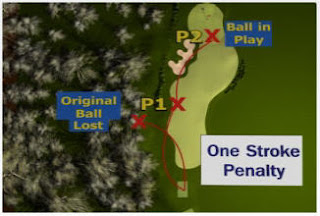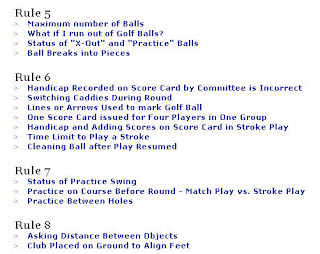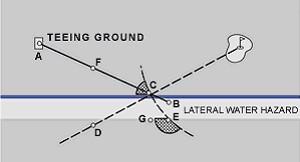I can’t understand why everyone doesn’t play golf, but even more than that I don’t understand why some people that do play have no idea how to navigate a golf course. I don’t like five hour rounds. Correction – I hate five hour rounds. I’ve never heard anyone say “That round was way too fast. We need to slow down next time.”
All too often while waiting on the tee I see two carts sitting side by side up ahead. Three of the guys are sitting in the carts, one is on his phone, and one is telling the other guy about the birdie he made on this hole in ‘96 or ‘97. The 4th guy is standing next to his drive doing his best Tiger Woods grass toss, trying to figure out how this 2mph wind is going to affect his upcoming bladed 5 iron. Having decided it’s a two club, wind he pulls the 7. Now the fun begins: practice swing, practice swing, practice swing… no, wait. He’s only 210 out, 2mph downwind. It’s got to be the 8 – he saw Bubba hit this exact shot last week. The fact that he just ripped his driver 190 never enters his mind. Four more practice swings, this time with the 8, then pures it 70 yards. Still not out of our landing area, but on to player #2 where the show begins again then again and one more time. Unless the 2 players in one of the carts are women. Most women hit it then hit it again until they get to the green where they are lining up their putts while watching their husbands toss grass in the air.
Golf is hard, playing golf doesn’t have to be. Golf is a game where you police yourself and call penalties on yourself. Only you can speed up play – unless you are scared of those 90 year old volunteer rangers that most courses use now.
Here are a few easy things that everyone can do to make golf more enjoyable for everybody.
1. Play the right tees. Most scorecards have recommended tees based on handicaps. A better way may be to look at the holes on the card. You should be able to comfortably hit a 6 iron or less to most of the par 3’s and 4’s.
2. Practice on the range, play golf on the course. The only time I take practice swings on the course is when I’m trying to stay loose because I’m waiting, I have a difficult stance or lie, on chips to get a feel for the lie, or if I’m trying to hit a big draw or fade. Three or four practice swings on every shot just wastes time and wears you out.
3. If you’re the longer hitter in your cart, walk to your ball and get ready to hit while your partner is getting ready. Take a couple clubs with you; twenty seconds after your partner hits you should be pulling the trigger. Even if you grabbed the wrong clubs he can drive over and you’re ready to go.
4. Unless you’re playing in a tournament, play ready golf. Common decency tells you an eagle or birdie has honors, but any other time, hit at will. Same goes for around the green. If you have a 50+ foot putt and no one has made it to the flag to tend it, putt it if you’re ready. Chances are it’s not going in. If it does and you’re playing a friendly round, nobody’s going to make you take that penalty.
5. Be aware of your surroundings. Park the cart on the path at the back of the green. If you brought a club with you to chip, lay it at the back of the green after your chip so you can pick it up on your walk back to the cart. Start lining up your putt and fixing ball marks while others are putting as long as you can stay out of their line.
6. Write the scores down on the way to the next tee. No eagles or birdies? Grab your club and swing away.
*This post is a section taken from my “bio page” which is here.
Editor’s note: I had a discussion with some people on twitter yesterday after a 5+ hour round. Here are some ideas we threw around:
Golf courses – offer green fee discounts to people who play in less than 4 hours. Perhaps in rebate form, or in discount on their next round.
Public/private courses with members who don’t pay green fees? Maybe a discount on monthly minimums. Or, how about a rewards program/points card. Every time they play in less than four hours they get points towards money to spend in the pro shop.
Any course – Use your marshals to move people along! Also, implement a “wall of shame,” on which you display photos of players who take more than 5 hours a round.
But, since golf courses are like highways and one slow group causes a traffic jam, only penalize the first group that fell behind. This one’s tricky because you’d need a marshal out there to identify the offenders. And if he’s out there and didn’t speed them up – he’s the one who should be penalized! Offer a drink or something to the groups whose rounds were miserable behind them.
Other ideas? Please share in the comments!
– Kristen @thegolfchick




Can I Get a Ruling?
Should Tiger have incurred a two stroke penalty on the 13th hole in the first round at The Masters?
Tiger Woods, Jeev Milkha Singh and Stewart Cink all landed the 13th green in two on day one at Augusta. Tiger and Stewart both missed their eagle putts. Tiger walked up to his ball, marked and lifted it, then looked around for Jeev. After getting Jeev’s attention, Tiger pointed at his own marker as if to ask “is that in your way?” Indeed, he ended up moving his marker off the line and Jeev made his eagle. So the question is:
Did Tiger give advice to Jeev by indicating the line of the putt? The USGA defines advice as: any counsel or suggestion that could influence a player in determining his play, the choice of a club or the method of making a stroke. The penalty for a breach of either rule 8-1 or 8-2 is two strokes.
Any rules wizards out there? I’m not trying to be a narc, I just like to understand the rules as best I can.
Next post.